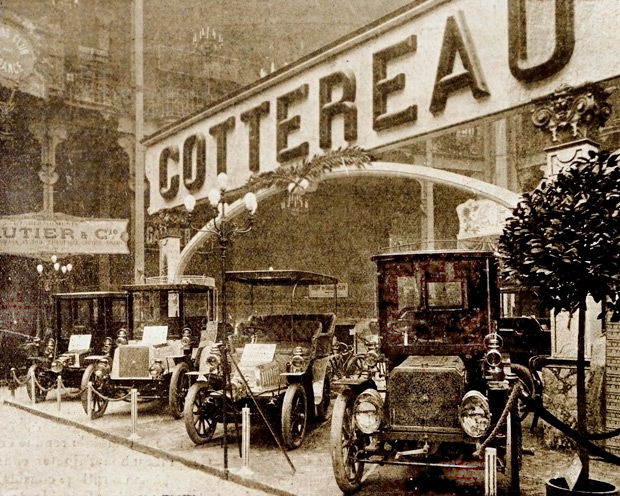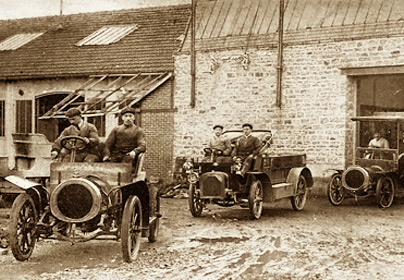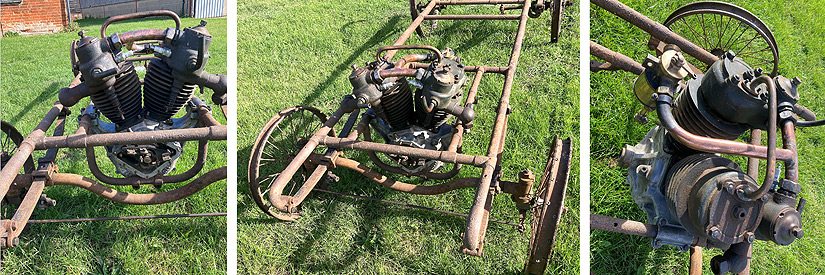Another interesting
photo received from our Forums Sleuth, Mark Dawber (New
Zealand), from a
forum of old photos asking for more information on the vehicle which
seen in front of the Neuvon Railway Viaduct. Top shows theviaduct in c1903
and the lower photo shows the viaduct as it is today. Looking at the upper
photo shows a railway train of some considerable length being pulled by a
single steam engine.
Research advises that Neuvon Railway
Viaduct is a curved semi-circular arch masonry railway bridge built in
1849 in eastern France. The 236 metre long viaduct is 23 metres high and
has 16 arches which cross the valley at Plombières lès Dijon. The town
is located west of the major city of Dijon on the railway line between
Lyon and Paris, by the river Ouche. The horizon is a silhouette of the
hill of Notre-Dame d'Etang on what used to be the estate of the Abbots of
Saint Bénigne. The Neuvon viaduct was partially destroyed in September
1944 but the first convoy was able to cross wooden scaffolding in February
1945.
The car in the photo has a radiator shape of a number of cars at the time,
but also has a circular silhouette occupying the middle of the radiator,
not a feature that other cars with similar radiators possessed. The
silhouette suggested an air-cooled car, with the circle probably being a
cooling fan. Consultation with our Ariejan Boss advised that he had
studied this mystery photo previously but had not reached a conclusion.
Fresh researches now have suggested that this appears to be a cca 1903
Cottereau with a radiator shape the type that was on one of the cars on
their stand at the 1902 Paris Salon in December (photo below, car on
right.) The photo also shows that at this time Cottereau had not settled
on the more familiar circular bonnet and radiator pattern of radiator they
carried on with for quite a number of years (as shown on the photo below
right of their factory, car on left and right). Study of the right photo
shows the contours of the fan behind the radiator. Another factor
advancing the Cottereau theory, is that Cottereau cars were made in Dijon,
not far from the scene of the photo, but very long distance from the main
French car manufacturing centre of Paris, - some 300km away.


Louis Cottereau was a professional international racing cyclist, who with
his brother Henri,founded Cottereau & Cie of Dijon in 1891, to build
bicycles in the Lentillieres district of Dijon. Subsequently, using
bicycle technology, they built their first car in 1898 using a V-twin 5HP
1272cc air cooled engine to power a small voiturine vehicle which was
steered by a handlebar. In 1900 the engine was enlarged to 9HP at 1884cc ,
and by 1901 they were offering 5HP, 7HP, and 9HP V twins and a 10HP Four.
The early four was two twins in line. Same year Cottereau cars were made
under licence in Paris by EJ Brierre. Cars, now wheel steered, had gained
water cooled heads and, depending on size, had single or twin chain drive.
Below is a photo of a period Cottereau chassis with a two cylinder V engine.

1905 to 1909 they also made motorcycles. By 1909 Cotterau had become a
quite large company employing over 360 people. After trying a number of
various styles of radiators used by their fashionable competition,
Cottereau cars started to become characterised by their circular bonnets
and radiators. To advertise the brand Cottereau had entered racing and
adopted a slogan which in Latin advised 'In Hoc Signo Vionces' (In this
sign I conquer).
However, only limited successes ensued, and despite the availability of
numerable models of cars, sales slowed to a point in 1910 when the company
was taken over by 'Constructions Industrielle Dijonaise, CID. The
Motorcycle manufacturing facilities were bought by Terrot. CID, which was
effectively a financially reconstructed Cottereau, carried on
manufacturing two ranges of cars up to the start of World War 1, but did
not survive thereafter. The CID Baby Two-Seater was their best-known model
with a 8 HP Buchet engine, a four speed friction transmission, and
transverse front spring. The CID Baby was Sold in England, as was a
version called the Emeraude, similar car but with semi elliptic springs.
We have covered the CID Baby a couple of times in these Help Pages and
connections with 'Cummikar'. |